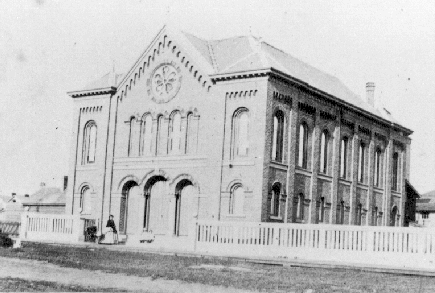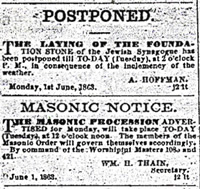The Synagogue of Congregation Emanu-El
“As this stone which we are about to lay will be the foundation upon which this structure will rest, so let peace and harmony be the foundation stone of your hearts...” -Mr. S. Hoffman, Vice President of Congregation Emanu-El,at the laying of the Synagogue cornerstone, June 2, 1863

With initial costs in excess of $9000 in 1863 dollars, the temple was a tremendous undertaking for a small Jewish congregation composed of fewer than fifty members. A building committee was established to canvass the community for donations, which were successfully received by a diversity of local Victorians.
The laying of the cornerstone of the Hebrew Synagogue made favourable news headlines in 1863. The ceremony was claimed as the first public activity to attract official attendance of Victoria’s Masonic fraternity. In addition, the cornerstone that was laid is recognized as signifying the first foundation of a place of Jewish worship in Queen Victoria's West Pacific dominions. Invitations to participate in the parade and ceremony of June 2, 1863 were accepted by the French Benevolent Society, the Hebrew Benevolent Society, Germania Sing Verein (German Singing Club), St. Andrew's Society, and the Fraternity of Ancient, Free and Accepted Masons. The large group made for a decorative and diverse procession, and the noise en route to the Synagogue site was magnified by the music of a Royal Navy band from the H.M.S. Topaze.

In contrast to the other ceremonies featured on this website, two cornerstones were laid at the Synagogue site. The first was set in place by Mr. Malowanski, a member of the Synagogue Building Committee, and the second laid by the Worshipful Master of a local Masonic Order. Responding to the Masonic Officers and participants present at the afternoon ceremony, the Right Worshipful Master of Masons stated “I beg to express the honor we feel in being invited to take part in any ceremony having a holy useful, or benevolent design and more particularly in aiding in the erection of a Temple to be dedicated to the glory of God and his Holy name.” The jointly coordinated activities of the Synagogue ceremony reflect the historic relationship between the Jewish community and members of the Masonic Craft, dating back to the construction of Solomon's Temple.
Large-scale renovations of the Synagogue were completed in June of 1982. As part of the restoration process, the foundation of the building was disturbed and the contents of the historic time capsules were found. Pictured here is the original copper box, which we can assume to have held the contents that were deposited by Mr. Malowanski. It is interesting to note that the daily newspaper made no specific mention of a copper box when reporting on the 1863 ceremony. Many other cornerstone reports for various Victoria buildings reference the deposit of such behind the cornerstone, indicating that copper was a common material used for preservation purposes in Victorian times. While Victorians believed that copper would seal and preserve, this was not so. The copper box, exhibited on display at the temple Emanu-El, still contains the remains of the daily papers, which had disintegrated by the time the box was found.
The laying of the Synagogue cornerstone on Cormorant street was extolled (and continues to be extolled) as an important community gathering for the people of Victoria. While it is true that colonial citizens in the Victorian period did much to enforce an attitude of arrogance and social stratification, an investigation of cornerstone history enables us to remember moments that softened the edges of early racial politics in British Columbia. The newspaper notes that English, Hebrew, and German languages were all spoken aloud as the Synagogue ceremonies progressed through the afternoon, and Mr. S. Hoffman was quoted as stating “For, as I look around me, I behold adherents to every creed…” The pride articulated in this statement suggests that the participatory nature of the ceremonies was deliberate and well-intentioned. Alongside the important Jewish documents that were deposited below the cornerstone, the French Benevolent Society and Germania Sing Verein were given an opportunity to deposit their membership lists as well.
History has shown that dichotomous expressions of social inclusion played out across the Canadian landscape during Victorian times. It is fact that a diversity of citizens participated in the Synagogue festivities on June 2, 1863, as discussed above. It cannot be overlooked, however, that members of local indigenous nations were completely ignored in the official ceremony. This exclusion of indigenous peoples characterizes every cornerstone celebration featured on this site. It is, therefore, important to remind ourselves of the contradictions that exist in prominent civic ceremonies of the past and present. The laying of the cornerstones for the Synagogue of Congregation Emanu-El should be understood as an important event in the history of Victoria, highlighting the complex intersection of race, culture, business, and community.






